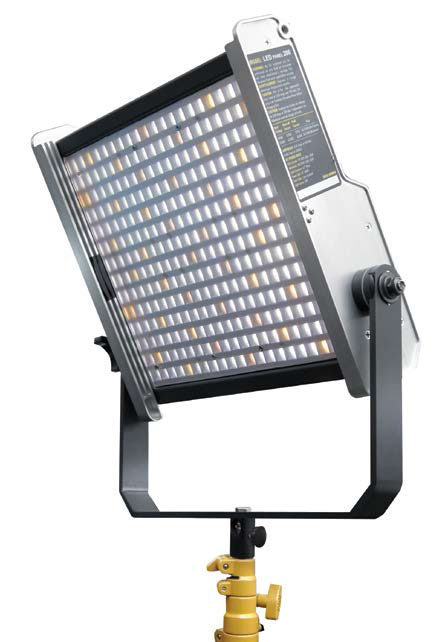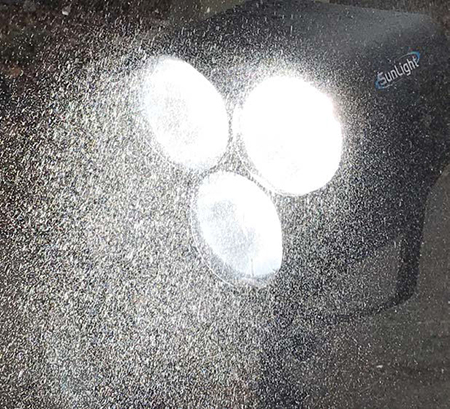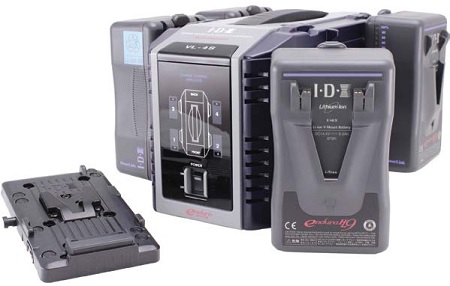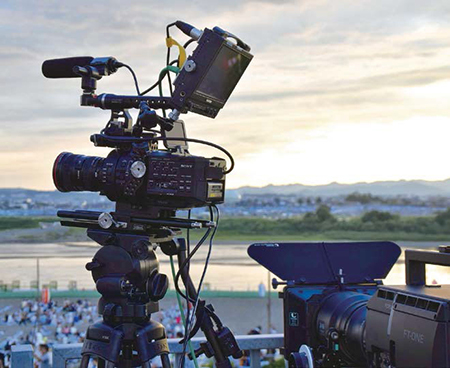New Gear for ‘On the Go’ News Crews
SEATTLE—Take it from a former news shooter: we news photogs are tough on equipment. We may take extra care with the camera and its lens. But other parts of our kit, including lights, batteries and camera support equipment, are going to get thrown around. So makers of gear on the go have to design ruggedness into those devices.
LIGHTING EQUIPMENT
One of the specs that buyers of news field gear look for when evaluating equipment is an IP65 rating, which means that the unit is dustproof and can withstand spray from waterjets for 15 minutes from any angle. That doesn’t allow immersion in water, though some manufacturers give anecdotal examples where a device was retrieved from a pond, dried out and put back in service. (Your results may differ.)

Flutoc Starmaker LED panel Getting the IP65 sand and waterproof rating means “you have to send your lights to a qualified, certified laboratory,” said Fluotec chief marketing officer Jose Noriega. He said it took the company nearly a year to design the Starmaker fixture to meet the test’s requirements. Since then it’s had a lot of news photog testing by storm-chasers.
Videssence looked at the detachable barn doors on many field lighting fixtures and saw a weakness. So on their Little Vid 50W LED fixture, barn doors are not removable. “That way the news guys can’t lose them when they’re working fast,” said Gary Thomas, the company’s national sales manager. The hinges on the barn doors can also be tightened with a screwdriver.
Litepanels’ Brick fixture sports a cast aluminum body that comprises the back and the sides. “There is nothing in the body to break apart,” said Byron Brown, global product manager. “And then there’s a one-piece lens that isn’t glued in place but uses an Oring and bolts into the aluminum body.”
“During development there’s a lot of environmental testing,” he said, “which is every bit as important as the optical and color performance.”
Walter Lefler, co-founder and chief technical officer at AAdynTech, said his response to any customer who dropped one of the company’s Jab Hurricane fixtures into water was the same as the food on the floor five-second rule: “If you pick it up in five seconds, you can still eat it.” A five second dunking should still allow the light to still be used—which it did—according to Lefler.
Get the TV Tech Newsletter
The professional video industry's #1 source for news, trends and product and tech information. Sign up below.
The soft illumination of a fluorescent tube lighting fixture is well known, but the fragility of those tubes has kept news photogs from deploying them in the field. BB&S Lighting developed its LED-based Pipeline system with the form factor of a fluorescent tube, but with a toughness that would give any light a run for its money. “It’s built with an all-aluminum backchannel, so you can’t bend it,” said company partner Toby Sali. “You can drive your car over it and not crush it.”
Cineo’s president and chief executive officer Rich Pierceall pointed to the Maverick as his company’s “tough-as-nails” news light. “Our products are built of anodized aluminum, which we find is the best balance between weight and structural rigidity,” he said. “And one way of keeping the on-light controls from being damaged is to recess them to keep them from being bumped.”

Frezzi’s SunLight LED fixture Pierceall said Cineo now offers strong but lightweight corrugated plastic cases a news cameraman is more likely to use to carry and protect his lights.
When Frezzi designed its new SunLight LED fixture, the housing followed company history, said Kevin Crawford, COO and vice president of engineering. “Lighting, for us has always been all metal chassis, aluminum or stainless steel, no plastics,” he said. “We also seal all the electronics inside the light, and we go to great pains with double wall housing so if there’s any water that gets in, it won’t reach any of the sensitive electronics.”
POWER SUPPLIES
With all the attention that fires from lithium ion batteries have drawn, makers of battery packs for news photographers have gone the extra mile to make sure that damage to the outside doesn’t cause the LI cells inside to burst into flame.

IDX HL9 battery packs IDX Systems designed its HL9 battery packs to be hermetically sealed. “The sealant process keeps the housing, the casing completely sealed,” said George Kusaba, marketing specialist. “This helps in terms of just keeping dust out, and keeping the internal structure of the battery safe, even if the case is dropped.”
On its newer battery packs, small molded ribs are wrapped around the inside of the battery. “They kind of just hold the cells in place,” Kusaba said. “So if it were to be dropped, it would provide structural support.”
Anton/Bauer’s product manager Andrew Butler noted that in addition to the ruggedness of battery pack cases, they need “a lot of levels of electronic safety protection built into them.” As an example, if one cell degenerates it will draw power from other cells around it, which can begin a cascade. “So our batteries are designed to avoid that propagation, with fusing between the cells.” He said that one final measure of safety is a current interruption device. “It’s basically a diaphragm that disconnects the internal electrodes of the battery from the outside, and it renders the battery completely inert.”
Kevin Crawford of Frezzi echoed the importance of electronic protection so that a lithium ion battery pack takes itself offline if its operation gets out of specification. And he remembered that less attention was needed in the cell packing when NiCad batteries were used. “With lithium ion cells, we use a special technique and foam so assure there’s no movement inside.”

Libec’s RSP-750 tripod systemTRIPOD SYSTEMS
Jose Larios head of sales and marketing for Libec, pointed to his company’s RSP-750 tripod system as the news cameraman’s camera support that can stand up to rough treatment. “[Both the carbon fiber and aluminum] legs can withstand hits and so on, and not bend or break. At worst, they might get a small scratch.”
And though Libec hasn’t had any returns because of damage to its RSP head in the five years it’s been sold, they designed it for quick repair. “The head’s designed sectionally, so for example if it falls and gets a really hard impact, and something chips, you’re able to replace just that section, you don’t have to replace the whole head,” he said. “It’s not going to be a very large cost; you just have to replace that section.”
Shotoku has had a lot of experience building tripod systems for outdoor broadcast remotes before it undertook design on its SH 100 tripod system, aimed at news shooters. “We kind of back-engineered from that point of view,” said Graham Ramsey, senior advisor at Shotoku Broadcast Systems. “We’ve learned it’s better for the knob to break than for the internals to break. Replacing a knob is quite easy. Sacrificial failure of the knob is better than causing damage internally.”
Providers of field news gear put their prototypes through a series of tests to make sure they’ll hold up. According to Sachtler’s Tobias Keuthen, director and global product marketing management at The Vitec Group, they test their Video 18 tripod leg brakes through 30-thousand cycles. “That means that you open the clamps, you release the legs, you push the legs back in and close the clamp again, 30,000 times,” he said. “And we do this under different environments.”
Gus Harilaou, regional manager, The Americas, for Miller Camera Support said the company’s System ArrowX 3 Sprinter II is ready for rough treatment. “We do not use any plastics or composites,” he said. “Everything’s machined metal. Even with the constant banging around, it doesn’t really affect or damage the head internally.”
